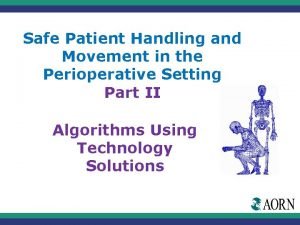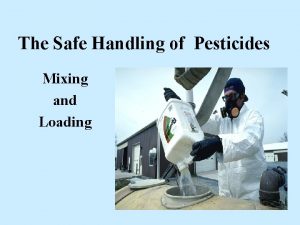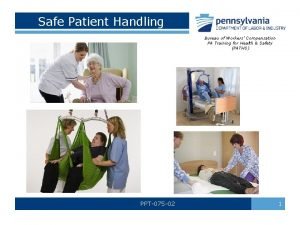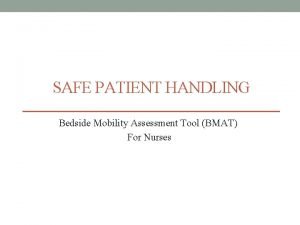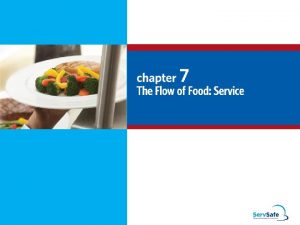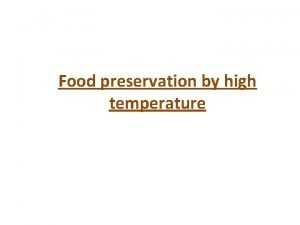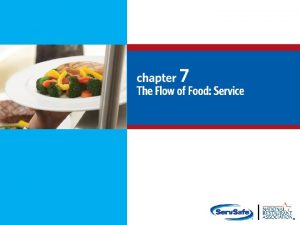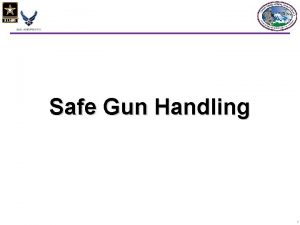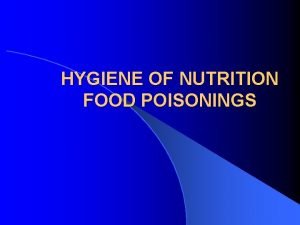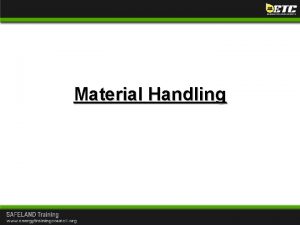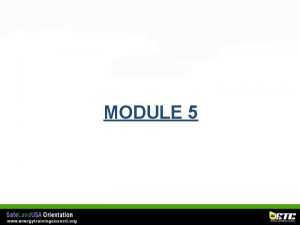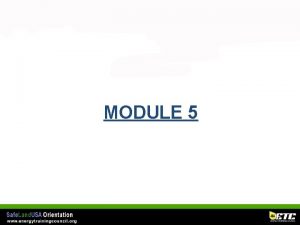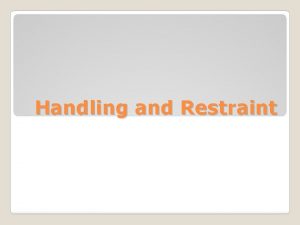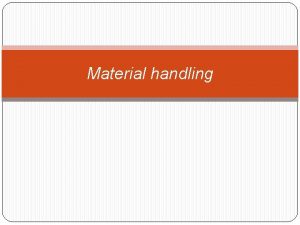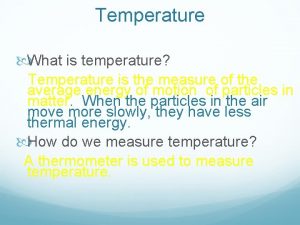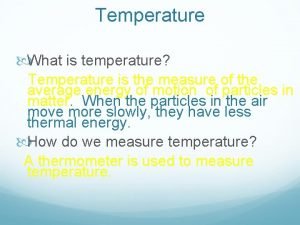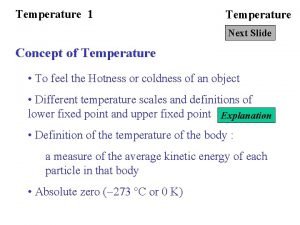Safe Food Handling Temperature Control most food poisonings














- Slides: 14

Safe Food Handling

Temperature Control • most food poisonings are caused by temperature abuse during the storage of hazardous foods This includes storage in the refrigerator and storage or holding hazardous food on a steam table at improper temperatures. Other causes of food poisonings are cross-contamination of raw and ready to eat foods, improper cooking, improper reheating or cooling of hazardous foods, improper or lack of handwashing and food from unsafe sources. • use a probe thermometer to take the internal temperature of food Procedure for using your probe thermometer: 1. The probe must be inserted to the thickest part of the food. Make sure the probe does not touch bone or the container. 2. Clean and sanitize the probe after each use and before inserting it into the next food item.

The Danger Zone • the Danger Zone is the temperature range between 4 C and 60 C Keep food out of the Danger Zone. Bacteria will multiply quickly in the Danger Zone. Bacteria grow extremely well at body temperature (37 C) • keep hot food hot (60 C or above) Have a probe thermometer available to check the temperature of the food on the steam table and on the stove. Cover food to keep the heat in and to prevent contamination. • keep cold food cold (4 C or below) Provide a reliable thermometer to ensure properation of the refrigerator. Place food in the refrigerator so that air can circulate around it freely to maintain proper temperature. • do not allow hazardous food to be in the Danger Zone longer than 2 hours when preparing food Move hazardous food through the Danger Zone as quickly as possible.

• cool food quickly using shallow pans or an ice bath Do not allow food to cool to room temperature before chilling in a refrigerator. • quickly reheat food to at least the original cooking temperature Make sure all hazardous food is cooked and reheated to an internal temperature as listed below. Check internal temperatures with a probe thermometer. See temperature chart on next slide.

Hazardous Food Item Cooking C (F) for 15 seconds Reheating C (F) for 15 seconds Poultry: Whole 82 (180) 74 (165) Poultry: ● other than whole poultry ● all parts of ground meats that contain poultry 74 (165) Pork and pork products. All parts of ground meat, other than ground meat that contains poultry 71 (160) Fish 70 (158) A food mixture containing poultry, egg, meat, fish or another hazardous food

• cook hamburger (no poultry) all the way through to an internal temperature of 71 C, making sure the juices run clear and the meat is brown grey Ground meat is very dangerous as the pathogens are mixed throughout the meat mixture in the grinding process. An illness caused by eating improperly cooked ground meat, commonly known as “hamburger disease, ” is caused by E. coli. • make sure poultry is fully cooked. Do not partially cook poultry and finish cooking it at a later time Poultry is one of the most common sources of foodborne illness. Assume all poultry is contaminated with pathogenic bacteria. Salmonella and Campylobacter are the most common types of pathogenic bacteria associated with poultry.

Defrost Food Safely • keep frozen food below -18 C Pathogenic bacteria do not grow below -18 C but will survive. • storing hazardous food at -20 C or below for 7 days or at -35 C or below for 15 hours will kill parasites and their eggs Food can also be stored at -18 C or below for 21 days to kill the parasites and their eggs. • food can be safely defrosted in the refrigerator, under running cold water or in the microwave Food can also be cooked from frozen safely. • make sure the outside of the food is kept cool and out of the Danger Zone Defrost and clean refrigerators regularly for efficient operation. All interior surfaces, racks, trays and the fan grill must be washed and sanitized at least once a week to prevent odours and maintain cleanliness.

Cross-contamination • cross-contamination occurs when safe to eat food comes into contact with pathogenic bacteria, chemicals or unwanted items making the food unsafe to eat This commonly happens in three ways: 1. raw food or its juices come in contact with cooked food 2. using the same equipment, to handle raw and cooked food 3. contaminated hands touching food

PREVENT CROSS CONTAMINATION • store cooked or ready to eat food above raw food or in a separate refrigerator This will prevent the juice from raw food dripping into cooked or ready-to-eat food. All food must be covered when stored in the refrigerator to protect it from contamination as well. Do not store food on the floor of walk-in-refrigerators. • make sure cutting boards, knives and equipment are cleaned and sanitized after they come in contact with hazardous food When cooking meat, use separate tongs to handle raw and cooked meat. Do not place cooked meats on the same plate that had the raw meat on it. When cooking meat, do not brush marinade on the meat in the last 10 minutes of cooking as this contaminates the cooked meat with raw juices. When tasting food, use the two spoon method to prevent cross-contamination. One spoon scoops out the food and places it onto the second spoon. The second spoon is used to taste the food. • label chemicals and pesticides and store them in a separate area away from food Mops, brooms and brushes must be stored in a separate room.

WASH YOUR HANDS Frequent hand washing can reduce the chances of catching a cold or flu during the winter months by over 80%.

Handwashing Wash your hands after: • • • handling hazardous or raw food sneezing or coughing touching something contaminated (e. x. , pet) smoking using the washroom Many Pathogens are passed between people through improper handwashing when handling food. Handwashing is the best way to prevent the spread of disease. Hands must also be washed before starting work, before handling any food, whenever they are visibly dirty or after finishing one job and before beginning another job.


Glove Use • using gloves does not replace hand washing • only a tool and must be used properly • plastic or latex gloves can be used to prevent cross-contamination in the following manner: o washing hands thoroughly before and after wearing gloves o any cuts or wounds on hands are properly bandaged and protected o replace gloves after each task o gloves are properly stored to protect them from contamination

Personal Hygiene • hair needs to be tied back • wear clean clothing and cover with a clean apron • do not handle food if you are ill with diarrhea, coughing or sneezing • do not handle food if you have open cuts on your hands or wearing band aids
 Safe feed safe food
Safe feed safe food Handling patients
Handling patients Safe handling of pesticides
Safe handling of pesticides Safe patient handling
Safe patient handling Bmat assessment
Bmat assessment Range safety rules
Range safety rules Us powerboating safe powerboat handling
Us powerboating safe powerboat handling St lawrence & atlantic railroad
St lawrence & atlantic railroad Safe people safe places
Safe people safe places Holding food without temperature control
Holding food without temperature control High temperature food processing
High temperature food processing Cold holding
Cold holding Difference between curie temperature and neel temperature
Difference between curie temperature and neel temperature Difference between curie temperature and neel temperature
Difference between curie temperature and neel temperature Difference between curie temperature and neel temperature
Difference between curie temperature and neel temperature

